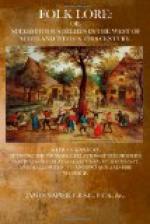on St. John’s eve and cut it in two, and if
the seeds on each half were found to be equal in number,
this was a token that these two would be soon united
in marriage; or if the halves contained an unequal
number of seeds, the one who possessed the half with
the greater number would be married first. If
a seed were cut in two, it denoted trouble to the
party holding the larger portion of the seed.
If two seeds were cut, it denoted early death or widowhood
to one of the parties. If the apple were sour
or sweet, the flavour indicated the temper of the parties.
There was a practice common among young people of peeling
an apple in an unbroken peel, and throwing the peeled
skin over the right shoulder in order to ascertain
from the manner in which it fell, first, whether the
person who threw it would be married soon, and second,
the trade or profession of the person to whom they
would be married. If the skin after being thrown
remained unbroken, they would be married soon, and
the person to whom they would be married was ascertained
from the form which the fallen skin presented; this
form might assume the shape of a letter, in that case
it was the initial letter of the unknown parties name,
or it might assume the form of some trade tool, &c.
Imagination had free scope here. The apple tree
itself was considered a lucky tree to have near a
house, but its principal virtue lay in the fruit.
Holly. This name is probably a corruption
of the word holy, as this plant has been used from
time immemorial as a protection against evil influence.
It was hung round, or planted near houses, as a protection
against lightning. Its common use at Christmas
is apparently the survival of an ancient Roman custom,
occurring during the festival to Saturn, to which
god the holly was dedicated. While the Romans
were holding this feast, which occurred about the
time of the winter solstice, they decked the outsides
of their houses with holly; at the same time the Christians
were quietly celebrating the birth of Christ, and
to avoid detection they outwardly followed the custom
of their heathen neighbours, and decked their houses
with holly also. In this way the holly came to
be connected with our Christmas customs. (See chapter
on Festivals.) This plant was also regarded as a symbol
of the resurrection. The use of mistletoe along
with holly is probably due to the notion that in winter
the fairies took shelter under its leaves, and that
they protected all who sheltered the plant. The
origin of kissing under the mistletoe is considered
to have come from our Saxon ancestors, who regarded
this plant as dedicated to Friga, the goddess
of love.
The Aspen was said to have been the tree on
which Judas hanged himself after the betrayal of his
Master, and ever since its leaves have trembled with
shame.




